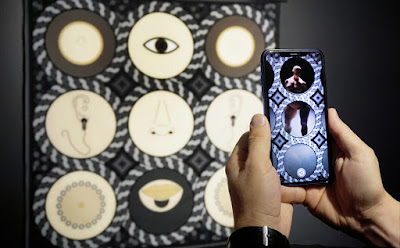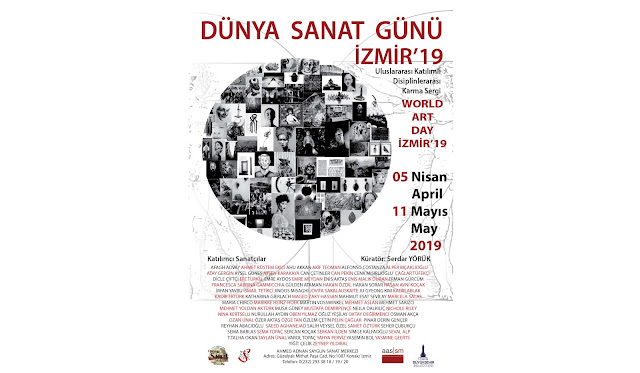Ekrana baktığınızda gördüğünüz milyonlarca ışık noktası, yani pikseller, aslında binlerce yıllık bir fikrin modern yansımasıdır. Her biri tek başına anlamsız, ancak bir araya geldiklerinde bir fotoğrafı, bir filmi, bir dünyayı var eden bu küçük kareler... Onların atası, toprağın altında sessizce yatan, elle kesilmiş küçük taş parçacıklarıdır: tessera. Tıpkı pikseller gibi, tek bir tessera da bir hiçtir; ama binlercesi bir araya geldiğinde, bir tanrının yüzünü, bir av sahnesinin vahşetini veya bir çiçeğin zarafetini ölümsüzleştiren hikaye anlatıcısı yüzeyler oluşturur. Dijital sanatın özü olan piksel ile antik dünyanın sanatsal zirvesi olan mozaik arasındaki bu kavramsal bağ, günümüzün en güçlü teknolojisi olan yapay zeka için belki de en zorlu sınavı sunuyor.
 |
| Ancient mosaic depicting a hand holding a flower - Created with ImageFX- 2025 May |
Tanecikten Anlama: Mozaik ve Pikselin Ortak Ruhu
Bir Roma villasının zemininde yürürken ya da Antakya'daki bir müzede devasa bir panoyu incelerken, aslında bir "veri yüzeyi" üzerinde geziniyorsunuzdur. Mozaik ustası, elindeki renkli taş, mermer veya cam parçalarını, her birinin rengini, şeklini ve hatta ışığı yansıtma açısını düşünerek yerleştirir. Bu yerleştirme sanatına "andamento" denir; yani tessera'ların izleyici gözünü yönlendiren akışı ve ritmi. Tıpkı bir ressamın fırça darbeleri gibi, bu akış da bir kasın gerginliğini, bir kumaşın kıvrımını veya suyun dalgalanmasını hissettirir. Bireysel tanecikler, bu ortak akış içinde anlam kazanır.
Bugün bizim piksellerle kurduğumuz ilişki de bundan farksızdır. Her bir pikselin RGB (Kırmızı, Yeşil, Mavi) kodlaması, ustanın elindeki renk paletidir. Bu pikseller bir araya gelerek, sadece bir görüntü değil, aynı zamanda bir duygu, bir bilgi, bir hikaye sunar. Mozaik zemini de, akıllı telefon ekranı da, temelinde taneciklerin bir araya gelerek oluşturduğu bir anlatı yüzeyidir.
Dijital Düşler ve Kırık Taşlar: Yapay Zekanın Mozaik Sınavı
Peki, bu kadar temel bir benzerlik varken, her gün inanılmaz görseller ve videolar üreten yapay zeka, neden mozaik sanatı karşısında aciz kalıyor?
Bu sorunun cevabını merak ederek, geçtiğimiz günlerde basit ama şiirsel bir prompt denedik: “Antik mozaik parçacıkları, bir parçacık animasyonu gibi savrularak bir araya gelsin ve bir çiçek tutan el figürünü oluştursun.” Bu fikri, metinden video üreten en iddialı platformlardan olan Luma Labs, Kling AI ve Google's Veo gibi araçlara sunduk. Sonuçlar, en iyi tabirle, hayal kırıklığıydı.
Yapay zeka, "mozaik" kelimesini bir stil filtresi olarak algıladı. Ortaya çıkan görseller, sanki bitmiş bir resmin üzerine mozaik deseni uygulanmış gibiydi; düz, ruhsuz ve en önemlisi, fiziksellikten yoksundu. Taşların teker teker yerleştiği, o tatmin edici "tık" sesini hayal ettiren birleşim animasyonu yerine, parçalar birbiri içinde eriyen, yapay bir akışla birleşti. Antik bir mozaiğe hayat veren o planlanmış kusurluluk, her bir taşın kendine has karakteri yok olmuştu. Ama yine de ilham verici sonuçlar çıktı.
Ustanın Dokunuşu, Algoritmanın Kör Noktası
Yapay zekanın bu başarısızlığının ardında, sanatın sadece nihai görüntüden ibaret olmadığını gösteren derin nedenler yatıyor:
Malzeme ve Kusurun Bilgeliği: Antik bir usta, her bir tessera'nın sadece rengini değil, dokusunu, damarlarını ve ışığı nasıl kıracağını da bilirdi. Bir gözdeki parıltıyı yaratmak için bilinçli olarak daha parlak bir mermer parçası seçer veya bir gölgeyi derinleştirmek için daha pürüzlü, mat bir taş kullanırdı. Yapay zeka ise, milyonlarca dijital görüntüden öğrendiği "ortalama" bir mozaik fikrine sahip. Onun için taş, sadece bir renk kodudur; ağırlığı, dokusu ve tarihi yoktur.
"Andamento"nun Grameri: Daha önce bahsettiğimiz "andamento", yani taşların akış yönü, bir mozaiğin gizli dilidir. Zeugma'daki ünlü "Çingene Kızı" mozaiğindeki gözlere bakın. O melankolik ve derin ifade, sadece renklerle değil, o gözlerin etrafındaki tessera'ların dairesel ve ustaca akışıyla yaratılmıştır. Yapay zeka, bir deseni doldurmayı bilir ama bir hikayeyi yönlendirecek bu görsel grameri henüz çözememiştir.
Optik İllüzyon ve Derzlerin Rolü: Mozaik ustaları, optik illüzyon ustalarıydı. Özellikle ince detaylar için kullanılan "opus vermiculatum" (solucanımsı iş) tekniğinde, minicik tessera'lar bir solucan gibi kıvrılarak neredeyse resimsel bir gerçeklik yaratırdı. Ayrıca, taşların arasındaki boşluklar, yani derzler, sanatın bir parçasıydı. Bu negatif alan, figürleri belirginleştirir, kompozisyona ritim katardı. AI modelleri ise genellikle bu boşlukları görmezden gelir, parçaları kusursuzca birleştirerek mozaiğin ruhunu oluşturan o el yapımı hissini yok eder.
Niyet ve Bağlam: Bir mozaik ustası, eseri yaparken onun nerede duracağını, hangi açıdan ışık alacağını, üzerinden kimlerin yürüyeceğini düşünürdü. Bir ziyafet salonunun zeminindeki tasvir, oradaki atmosferi zenginleştirmek için yapılırdı. Yapay zeka ise bağlamdan kopuktur. O, bir "görüntü" üretir, bir "mekan" veya bir "deneyim" tasarlamaz.
Geleceğin Eşiği: Bir Taşı Anlamak
Belki de üretken yapay zekanın sanatsal yetkinlikteki asıl eşiği, fotorealizm veya fantastik dünyalar yaratmanın ötesinde, bir gün gerçekten bir mozaik ustasının ruhuyla, her bir taşı tek tek "düşünerek" bir araya getirebilme becerisinde saklıdır. Sadece nihai görüntüyü değil, o görüntüyü oluşturan sürecin ardındaki binlerce yıllık bilgeliği, niyeti ve materyal bilgisini anladığı gün, yapay zeka bir araç olmaktan çıkıp bir sanatçıya dönüşebilir.
O gün gelene kadar, antik ustaların binlerce yıllık mirası, algoritmaların henüz çözemediği derin ve anlamlı bir sır olarak kalmaya devam edecek.
----------------------
The Pixel's Ancestor: Can AI Decipher the Soul of the Mosaic?
The millions of glowing dots you see on your screen—the pixels—are, in fact, the modern echo of a thousands-year-old idea. Each one is meaningless on its own, yet together, these tiny squares create a photograph, a film, a world. Their ancestor lies silently beneath the earth, a small, hand-cut piece of stone: the tessera. Just like pixels, a single tessera is nothing; but when thousands are assembled, they form storytelling surfaces that immortalize the face of a god, the ferocity of a hunt, or the elegance of a flower. This conceptual link between the pixel, the soul of digital art, and the mosaic, the artistic peak of the ancient world, presents what may be the toughest challenge for today's most powerful technology: artificial intelligence.
From Particle to Meaning: The Shared Soul of Mosaic and Pixel
When you walk on the floor of a Roman villa or gaze upon a massive panel in a museum in Antioch, you are essentially moving across a "data surface." The mosaicist placed each piece of colored stone, marble, or glass by considering its color, shape, and even the angle at which it would reflect light. This art of placement is called "andamento"—the flow and rhythm of the tesserae that guides the viewer's eye. Like a painter's brushstrokes, this flow allows one to feel the tension of a muscle, the fold of a fabric, or the ripple of water. Individual particles gain meaning within this collective current.
Our relationship with pixels today is no different. The RGB code of each pixel is the master's color palette. When assembled, these pixels present not just an image, but an emotion, a piece of information, a story. Both the mosaic floor and the smartphone screen are, at their core, narrative surfaces created by the assembly of particles.
Digital Dreams and Broken Stones: AI's Mosaic Challenge
So, if the fundamental similarity is so profound, why does artificial intelligence, which generates incredible images and videos every day, seem to fail when faced with the art of the mosaic?
Curious for an answer, we recently tested a simple yet poetic prompt: “Ancient mosaic pieces, like a particle animation, scatter and then come together to form the figure of a hand holding a flower.” We submitted this idea to some of the most ambitious text-to-video platforms, including Luma Labs, Kling AI, and Google's Veo. The results were, to put it mildly, underwhelming.
The AI perceived the word "mosaic" as a stylistic filter. The resulting visuals looked as if a mosaic pattern had been overlaid onto a finished painting; they were flat, soulless, and most importantly, lacked physicality. Instead of the satisfying animation of stones clicking into place one by one, the pieces melted into each other in an artificial flow. The planned imperfection, the unique character of each stone that gives an ancient mosaic its life, was gone.
The Master's Touch, The Algorithm's Blind Spot
Behind AI's failure lie profound reasons that prove art is more than just the final image:
Materiality and the Wisdom of Imperfection: An ancient master knew not only the color of each tessera but also its texture, its veins, and how it would refract light. They would deliberately choose a brighter piece of marble to create a glint in an eye or a rougher, matte stone to deepen a shadow. AI, however, operates on an "average" idea of a mosaic learned from millions of digital images. To it, a stone is just a color code; it has no weight, texture, or history.
The Grammar of "Andamento": The "andamento," the flow of the stones we mentioned earlier, is the secret language of a mosaic. Look at the eyes of the famous "Gypsy Girl" of Zeugma. That melancholic and profound expression is created not just by color, but by the circular, masterful flow of the tesserae around her eyes. An AI knows how to fill a pattern, but it has not yet deciphered this visual grammar that directs a narrative.
Optical Illusion and the Role of Interstices: Mosaicists were masters of optical illusion. The "opus vermiculatum" (worm-like work) technique, used for fine details, employed tiny tesserae that snaked along to create almost painterly realism. Furthermore, the spaces between the stones—the grout—were part of the art. This negative space defined figures and added rhythm to the composition. AI models often ignore these gaps, seamlessly fitting pieces together and thereby destroying the handmade feel that gives a mosaic its soul.
Intention and Context: A mosaic master would consider where the work would be, what angle the light would hit it from, and who would walk across it. A depiction on a banquet hall floor was made to enrich the atmosphere of that very space. AI is devoid of context. It produces an "image," not a "space" or an "experience."
The Future's Threshold: To Understand a Stone
Perhaps the true threshold of generative AI's artistic competence lies not in photorealism or fantastical worlds, but in its ability to one day assemble a mosaic with the soul of a master—by "thinking" about each individual stone. The day it understands not just the final image, but the millennia of wisdom, intention, and material knowledge behind its creation, is the day AI might evolve from a tool into an artist.
Until that day comes, the timeless legacy of the ancient masters will remain a profound secret that algorithms have yet to decipher.

.jpg)







Yorumlar
Yorum Gönder